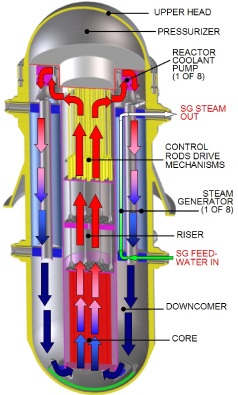I have posted several articles about small modular reactors (SMRs). So far, they only exist as designs and some test systems. The idea is to manufacture standardized parts in a factory to take advantage of economies of scale and standardization. They are designed to produce up to three hundred megawatts of electricity each. The modules are shipped to the site of the power plant and assembled.
There are multiple approaches to the design of SMRs and different companies are exploring these designs. The U.S. Department of Energy has been investing funds in this research. This new type of reactor is also being studied in the U.K. and the Republic of Ireland to help meet future energy needs. The Nuclear Free Local Authorities (NFLA) in the U.K recently published their assessment of the prospect of SMRs. Their conclusions apply to the situation in other countries as well.
No one has commercialized an SMR yet. None of the SMR designs has even been finalized. The licensing procedure for these SMRs will take five to ten years at least. There is no solid cost estimate for a commercial version of a SMR but, contrary to previous assumptions, preliminary estimates suggest that the SMRs will not be cheaper per watt than the current large scale reactors.
One of the big problems with SMRs is the fact that their manufacture will require a "massive supply chain." This supply chain will have to be created before a single SMR can be put into operation. The utility rate payers will ultimately have to fund the supply chain. However, in order for that to happen, the manufactures of SMRs will need many orders for their product. There has been no rush to order SMRs so it is sort of a chicken and egg thing. They need to be able to manufacture the SMRs to get orders but they need to get orders to finance the manufacture. Research on SMRs has been losing momentum because of the lack of a market for them.
Even if a design is chosen and a manufacturing facility is constructed with the requisite supply chain, there are other potential problems for SMRs. While the concept of standardization and production lines has worked very well to supply our modern age with many industrial and consumer products, it also has a great vulnerability. If mistakes are made in a design or in the conversion of the design to a finished product, then those mistakes will be present in all of the SMRs from that plant based on that design. Some design problems can take years to show up in nuclear reactors. If a potentially dangerous flaw surfaced after dozens of SMRs were constructed, shipped, installed and turned on, it would be very difficult to fix. It would not be liking recalling some cars because of a flaw in the engine. The tools that were needed to construct an SMR would be back at the factory. Repairs in the field would be complex and very expensive, if they were even possible once the reactor had been operating and was radioactive.
The cheerleaders for SMRs are vocal and very enthusiastic but there are very serious questions about the viability of the whole SMR concept. Public and private money would be better spent on renewable alternatives such as wind and solar power.
Artist's concept of a small modular reactor:
